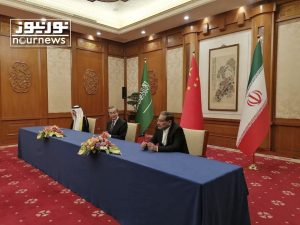In the past week, China’s role in brokering an agreement between Iran and Saudi Arabia to re-establish diplomatic relations has generated a considerable amount of commentary. It has also prompted discussion as to whether this heralds a new departure in Chinese foreign policy and its arrival as a major peacemaker in the Middle East.
Such claims are overstated. If anything, the agreement highlights the extent to which Chinese participation required a process to already be in place. That is not to diminish China’s involvement, however. As well as revealing some of the features of Chinese “quasi-mediation,” this episode also suggests how Beijing might engage with other regional conflicts.
In general, China’s aim has always been to maintain balance in its relations in the Middle East and the Gulf region and cultivate good economic and political relationships with all countries in the region. Yet underneath this overall position, the reality facing China is somewhat different. For one, China’s economic relations with Saudi Arabia and the Gulf Arab states are arguably more diversified and deeper than those with Iran, while Iran is more dependent on China for economic trade and political support than Saudi Arabia. Meanwhile, China’s aim for balance is undermined by the regional tensions and rivalries that operate regardless of Beijing’s wishes.
Indeed, the rivalry between Saudi Arabia and Iran threatens the wider Gulf region. That has implications for China and any expansion or deepening of economic ties by its state and private firms and nationals based there. Perhaps with that in mind, in 2021 then-Chinese Foreign Minister Wang Yi put forward a Five-Point Plan regarding regional security. While it reflected many of the statements made by Chinese officials, by having broad and general principles, it was also notable for making specific references to tensions in the Gulf and the need to resolve them via confidence building measures.
However, although China put forward this proposal, it did not take the lead in putting these aspirations into practice. Instead, it fell to other states, like Iraq and Oman, to facilitate a dialogue between the Iranians and the Saudis. The process that led to last week’s agreement was already in motion when China arrived on the scene. Indeed, as Cambridge University’s Bill Figueroa has memorably put it on Twitter: “China entered late, as the train was pulling out.”
Yet despite China’s late participation, the announcement of the agreement caught many in the China-Middle East scholarly and policy community by surprise. It has generated a lot of discussion about China’s prior involvement as well as what this may mean going forward. Perhaps unsurprisingly, this has led some commentators to ask what this means for the United States and its role in the region and whether it may even be sidelined as a result.
Speculation about U.S. marginalization is largely overblown. For one, the United States remains the Saudis’ principal ally, even as Riyadh has shown less willingness to defer to U.S. interests and become more autonomous and transactional in its foreign policy behavior. As for Tehran, while Iran’s leadership would welcome a more active Chinese presence and a reduction of U.S. influence, that is unlikely to happen. China may grumble and criticize U.S. intervention in the region, but when it comes to regional security and stability, Chinese interests partly overlap and complement Washington’s.
Instead, China’s efforts at peacemaking have been more modest, involving support from the sidelines. This is a stance that scholars like Sun Degang and Yahia Zoubir summarized as “quasi-mediation,” the features of which involved the following: revising rather than setting the agenda; encouraging conflict de-escalation rather than conflict resolution; and following rather than leading.
One notable example of Chinese “quasi-mediation” has already involved Iran. In 2015 the United States and other, mostly Western countries, reached agreement with Tehran to freeze its nuclear program with the Joint Comprehensive Plan of Action (JCPOA). During those talks, Beijing provided a useful bridge for both sides, helping to narrow the distance between them.
Since those original JCPOA talks, however, China’s subsequent involvement in peacemaking has been largely non-existent. In part this may be due to the intractability of some of the region’s most prominent conflicts, such as that in Syria or between the Palestinians and Israel.
Looking ahead, a “quasi-mediation” approach would be especially welcome in relation to the current stalled talks over the restart of the JCPOA. When the Biden administration came into office over two years ago, it indicated its keenness to return to the deal, which former President Donald Trump had abandoned, reimposing sanctions on Iran. Since then, optimism has dissipated and few expect that it will be resolved. However, if the Saudi-Iran agreement could somehow be used to kickstart the process, then this may be a useful entry point for getting Beijing involved.
































